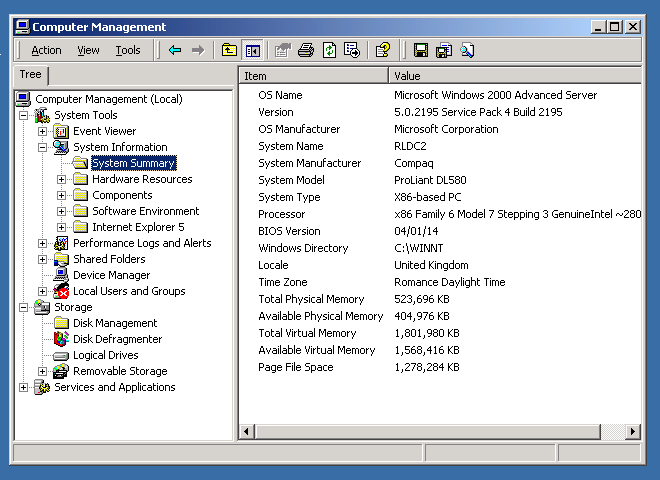Windows 2000 on libvirt
For the retro part of my home network, I have Windows 2000 Server running Active Directory, DNS, and DHCP servers on the retro VLAN. I was running this on Proxmox, but wanted to move this over to my Debian server running libvirt.
Rather than try to migrate the actual virtual machine, I installed a new instance of Windows 2000 Server under libvirt and added it as a Domain Controller.
libvirt has support for legacy operating systems, but its default configurations are not optimal and will cause difficulties.
Creating a new VM
When creating a new VM, pick your installation media. By default, libvirt won’t
detect Windows 2000. Open the search box and tick Include end of life operating systems,
then you can pick win2k.

On the last screen, tick Customise configuration before install.
Even when picking win2k, libvirt still defaults to using hardware that is not
supported out of the box by Windows 2000. We’ll make some changes to use hardware
that Windows 2000 has built-in drivers for.
Depending on your libvirt version, some of the hardware models listed below may not be in the options list. You can still type them in the dropdown, or use the XML editor to set them.
Network
There are 3 well-supported adapters available to use in libvirt/QEMU.
| ID | Model | Speed |
|---|---|---|
e1000 |
Intel PRO/1000 | 1 Gbit |
rtl8139 |
Realtek RTL8139 | 100 Mbit |
pcnet |
AMD PCNET | 10 Mbit |
Windows 2000 includes drivers for rtl8139 and pcnet but not e1000.
If you want gigabit, you’ll need a driver disk or CD for the PRO/1000. Otherwise, pick rtl8139.
Sound
If you want sound, set the model to ac97. Otherwise, delete the card.
Video
Set the model to cirrus.
This will limit you to 1024x768 @ 16 bit colour, or 1280x1024 @ 256 colour.
To get higher resolutions, you can use the model vmvga to emulate the VMWare SVGA adapter.
This requires drivers from VMware Tools version 10.0.12, the last to support Windows 2000.
https://packages.vmware.com/tools/releases/10.0.12/windows/
I extracted the Windows 2000 video drivers from this installer: https://dl.mroach.com/virt/vmvga_win2k.zip
CPU
You don’t have to change anything here, but I like to set the processor model to pentium3
to keep things authentic when looking at system info inside the VM.
High idle CPU usage
There’s one more issue to handle in VM configuration.
After installing Windows 2000, I noticed that qemu-system-x86_64 was using about
20% CPU consistently even though the VM itself was completely idle.
This is a known issue with some versions of Windows and the trick is to enable
the High Performance Event Timer which is switched off by default.
In the VM settings, go to Overview and then XML to edit.
In the clock element:
- Delete the
timerlines forrtcandpit - Change the
hpetline to bepresent="yes"
It should look like this:
<clock offset="localtime">
<timer name="hpet" present="yes"/>
<timer name="hypervclock" present="yes"/>
</clock>
Debian 12 Gotcha
Update: I found that deleting the hpet element entirely and deleting the
Tablet input device seems to solve the issue as well. (Reboot required after deleting the tablet.)
If you’re running this on Debian 12 “Bookworm” you’ll get an error:
unsupported configuration: hpet is not supported
This is a bug in libvirt 9.0 and it was fixed in 9.2. Unfortunately Debian 12 uses 9.0 and doesn’t have a stable backport. Debian 13 “Trixie” has libvirt 11.0 so this problem is solved there.
I tested this fix on my Fedora workstation running libvirt 10.6 and it works fine.
Bonus config
If you want to have the system information in Windows display a custom system manufacturer and model, you can edit the XML again to add some config. In my case, I wanted my VM to think it’s a Compaq ProLiant DL580
<sysinfo type="smbios">
<system>
<entry name="manufacturer">Compaq</entry>
<entry name="product">ProLiant DL580</entry>
</system>
</sysinfo>
Then, add one line to the os element:
<os>
<!-- snip type, boot -->
<smbios mode="sysinfo"/>
</os>

Dual CPU Problem
If your VM is configured with multiple CPUs and you install Update Rollup 1, you’ll notice 100% CPU usage after rebooting.
This is a known problem and the fix is modifying the Hardware Abstraction Layer via the registry. In Notepad, create a file with the following contents, save it, then install it.
Windows Registry Editor Version 5.00
[HKEY_LOCAL_MACHINE\SYSTEM\CurrentControlSet\Control\HAL]
"14140000FFFFFFFF"=dword:00000010
Beta Archive has an archive of KB919521 about this topic.
Conclusion
With a few tweaks to libvirt, we can run Windows 2000 smoothly as a guest.
If you know of any other good tweaks for running legacy operating systems under libvirt/qemu, please get in touch here or on Mastodon!
